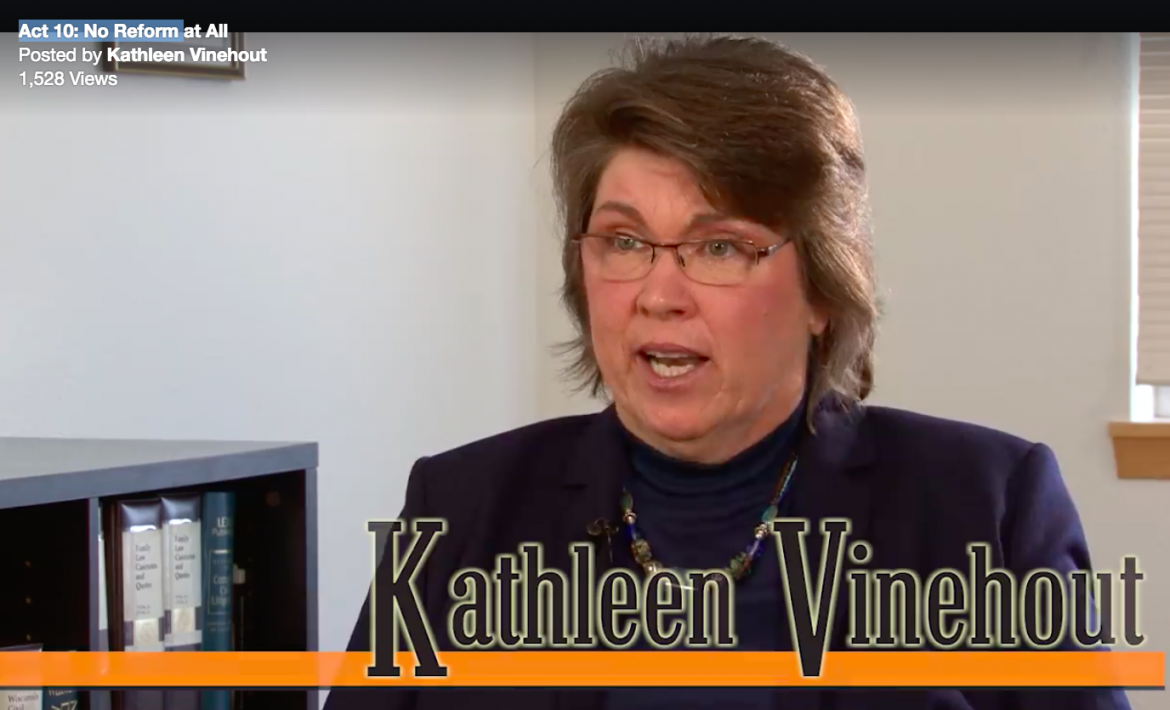Wisconsin state Sen. Kathleen Vinehout, a Democratic candidate for governor, published the following statement on Facebook on March 14, 2018:
“After Act 10 teachers left the profession. Young people going into teaching changed their majors. Now we have a teachers’ shortage. We must repair the damage done by Act 10. We’ve got problems now and they are only going to get bigger.”
The Observatory decided to check. We examined her statement as three separate items. The first being that after the enactment of Act 10, there has been an exodus of teachers in Wisconsin. The second that there are fewer young people pursuing teaching degrees. Lastly that there currently is a teacher shortage in the state.
When The Observatory contacted staff from Vinehout’s office, they provided us with multiple sources they used to support her claims.
Act 10 begins

Matt Baran / Creative Commons via Flickr
A protester signals his displeasure with Gov. Scott Walker’s plan, later adopted by the Republican-run Legislature, to strip collective bargaining rights from most public employees in Wisconsin, including teachers, during this Feb. 17, 2011 demonstration at the state Capitol in Madison. Sen. Kathleen Vinehout, who is running for governor in the Democratic primary, claims the change has harmed teachers and education in the state.
Wisconsin Act 10 was signed into law on March 11, 2011 by Republican Gov. Scott Walker. It reduced collective bargaining rights for state and municipal employees, which includes K-12 teachers. And it required teachers and other public employees in Wisconsin to pay more toward their retirement and health care plans.
The law weakened unions by implementing mandatory annual recertification elections and prohibiting paycheck deductions for union dues collection. It also eliminated teachers’ and other public employees’ rights to bargain about pay, hours and other conditions of employment.
Proponents of Act 10 argued the changes allowed schools to offset large cuts in general state aid by reducing districts’ cost to provide public employee benefits, thus preventing budget cuts from affecting students. Removing the requirements to negotiate over salary structures, hiring and working conditions would give schools additional flexibility to attract and retain higher-quality teachers, backers of the controversial law argued.
Have teachers left the profession?

A 2017 analysis by the Center for American Progress Action Fund, which is an independent, nonpartisan policy institute that advocates for progressive policies, shows that a large number of teachers have left the teaching profession in Wisconsin after the enactment of Act 10. This is especially true in the 2010-11 school year, when the increase in teachers aged 55 and over retiring jumped from about 15 percent in the 2009-10 school year to over 30 percent.
It is important to note that the findings of the Center for American Progress Action Fund includes all teachers who taught in Wisconsin public schools in a given year and didn’t teach in the year following. Some teachers later returned to their public school classrooms after gaps in their career.
This isn’t surprising as reports on the aftermath of Act 10 found teachers were spurred to seek retirement in order to keep early retirement benefits, such as health insurance. This surge in 2011 of teachers leaving the workforce was mostly teachers above the age of 55, which under the Wisconsin Retirement System is the minimum age to receive benefits.
After Act 10, the overall percentage of teachers leaving the profession rose from 6.4 percent in the 2009-10 school year to 10.5 percent in 2010-11, with exit rates remaining higher than before with 8.8 percent leaving in 2015-16.
The Observatory rates Vinehout’s claim that teachers have left the profession after Act 10 as Verified.
Fewer students studying education

When asked to verify that students are changing majors, Vinehout’s staff instead pointed us to data showing that fewer college students are pursuing education degrees.
Since the implementation of Act 10, there has been a decrease in enrollment in teacher preparation programs in Wisconsin, a University of Wisconsin-Madison report found. And according to a Journal Sentinel special report, 2015 saw the smallest group of juniors and seniors enrolled in teaching programs in over two decades.
For example, the Green Bay Press-Gazette reported that between 2009 and 2013, UW-Oshkosh saw the number of students majoring in education decline by 25 percent.
Urban Milwaukee has also reported that UW-Milwaukee has seen a decrease in education majors — 3,000 enrolled in the program in 2010, down to 2,300 in 2015. Over the same period, UW-Stevens Point saw an 18 percent decrease, from 1,400 students in 2010 to 1,150 in 2015.
According to a Wisconsin Center for Education Research paper from January, enrollment in Wisconsin’s educator preparation programs has declined by 35.4 percent between 2010 and 2016 — from 12,323 to 7,956. Program completers decreased by 14.5 percent from 4,007 to 3,426, and total licensure endorsements has fallen by 17.2 percent from 8,815 to 7,301.
The paper notes that it is tempting to label Act 10 as the cause of the decline as these decreases start in “earnest following the enactment of Act 10.” But trends for the same timeframe show there has been a decrease in teacher training and licensing nationwide — although less than in Wisconsin.
Nationally, total enrollment in educator preparation programs has decreased by 33.6 percent, total licensure endorsements have decreased by 15.7 percent and total program completers has decreased by 11.5 percent from 2013 to 2016.
After Act 10, the average experience level of teachers in Wisconsin also decreased, according to the analysis by the Center for American Progress. Teachers with less than five years of experience increased from 19.6 percent in 2010-11 to 24.1 percent in 2015-16. The average teaching experience has also decreased, from 14.6 years in 2010-11 to 13.9 in the next school year, a level at which it remained in 2015-16.
Although multiple factors influence educational outcomes, such as student demographics, parental involvement, teacher quality and government policy, research has shown that students perform better when taught by teachers with more experience, according to the Learning Policy Institute, which conducts and communicates research to improve education.
Proponents of Act 10 underlined that removing requirements to negotiate over salary, hiring and working conditions would give schools more flexibility to attract and retain higher-quality educators, but this doesn’t seem to be the case.
The Observatory rates the claim that fewer young people are pursuing teacher qualifications as Mostly True, because although Act 10 may be a factor, this is in fact part of a national trend.
Shortage of teachers?

With a large number of teachers retiring after Act 10 and dwindling numbers of new teachers entering the profession, it is no wonder that Wisconsin is currently experiencing a teacher shortage.
The Department of Public Instruction confirmed in an email that “the shortage exists but in particular fields of high demand,” including certain subject areas and in “cross-categorical” special education in which teachers are certified to educate students with varying needs. The shortage also exists only in some regions of Wisconsin, DPI spokesman Thomas McCarthy said.
The total number of teachers in Wisconsin has decreased by 2.2 percent between the 2009-10 school year and 2015-16, according to a 2017 report from the Public Policy Forum. The nonpartisan, nonprofit organization is dedicated to enhancing the government and development of southeastern Wisconsin by researching regional public policy issues.
According to a 2017 report by the Wisconsin Budget Project, Wisconsin school districts struggle to fill vacancies, especially in math, science and technology. The report notes that one reason for teacher shortages is high turnover.
Since the adoption of Act 10, there has been an increase in teacher turnover — when a teacher leaves one Wisconsin district for another the next school year. Interdistrict moves increased from 1.3 percent to 3.4 percent at the end of 2014-15, according to the Center for American Progress report.
“If you have excessive turnover of young staff, you are constantly in a building mode,” Ann Haack, Elkhart Lake-Glenbeulah school district administrator, told the Milwaukee Journal Sentinel in October 2016.
The Journal Sentinel examined spending and teacher data for 424 districts and found that 75 percent of districts were losing their teachers more often after Act 10 because a competitor offered better working conditions and compensation.
That turnover has been accompanied by lower, not higher, teacher salaries. According to the Center for American Progress, after Act 10, “year-over-year pay cuts were found across urban and rural counties” ranging from 2 to 3.4 percent when adjusted for inflation. The analysis also found that teachers with experience between five and 15 years have seen their annual salaries fall by an average of $4,273.
The Department of Public Instruction has started the Talent Development Initiative to recruit, retain and develop more teachers in the state. The agency also has loosened teacher licensing requirements hoping to tackle teacher shortages. Yet the shortage of teachers in certain fields and regions of Wisconsin continues.
The Observatory rates Vinehout’s claim that Wisconsin has a teaching shortage as Verified.
Sources:
Email, Sen. Kathleen Vinehout’s office, April 3, 2018
Email, Thomas McCarthy, communications director, Wisconsin Department of Public Instruction, April 27, 2018
Center for American Progress Action Fund, Attacks on Public-Sector Unions Harm States: How Act 10 Has Affected Education in Wisconsin, accessed on May 4, 2018
Milwaukee Journal Sentinel, Uncertain about future benefits, many veteran teachers are retiring early, April 15, 2011
GazetteExtra, Retirements in Elkhorn schools reflect statewide loss of educators, April 30, 2011
Journal Sentinel, Special Report, Schools face tougher task in finding teachers, Dec. 21, 2016
Green Bay Press-Gazette, Abundance of local colleges counters teacher shortage, Sept. 19, 2014
Urban Milwaukee, Murphy’s Law: Wisconsin’s Growing Teacher Shortage, Aug. 20, 2015
Wisconsin Center for Education Research, University of Wisconsin-Madison, Supply and Demand for Public School Teachers in Wisconsin, January 2018
Wisconsin Retirement System News Online, What’s My Minimum Retirement Age?, accessed on May 4, 2018
Public Policy Forum report, Stay in School: An Update on Teacher Workforce Trends in Metro Milwaukee, December 2017
Wisconsin Budget Project report, Budget Cuts and Teacher Shortages: With Fewer Resources, Schools Struggle to Find Educators, Jan. 12, 2017
Journal Sentinel, Special Report, From teacher ‘free agency’ to merit pay, the uproar over Act 10 turns into upheaval in Wisconsin schools, Oct. 9, 2016
Learning Policy Institute report, Does Teaching Experience Increase Teacher Effectiveness?, June 2016
Department of Public Instruction website, Talent Development Initiative, accessed on May 4, 2018

